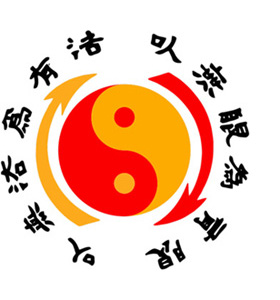
Jeet Kune Do
Jeet Kune Do (JKD) is “The Way of the Intercepting Fist”. It is the simple, direct,
non-classical martial art developed by renowned martial artist, action star and radical philosopher Bruce Lee in the late 1960s.
The name is derived from three Chinese (Cantonese) words. “Jeet” means to intercept or cut; “Kune” refers to the fist; “Do” is a way or system, the standard suffix for martial ways.

The Jeet Kune Do emblem, an adaptation of the well-known T’ai Chi symbol, was designed personally by the founder Sijo Bruce Lee, to represent the eastern dialectical concepts of Yin and Yang. Yin and Yang represent the two great opposite but complementary forces in the universe, with Yin representing darkness, passivity, pliability, or feminineness, and Yang representing light, activeness, hardness, or masculinity. The encircling arrows represent the endless interaction between Yin and Yang. The Chinese characters  encircling the emblem mean indicate "using no way as way, having no limitation as limitation." encircling the emblem mean indicate "using no way as way, having no limitation as limitation."
JKD’s foundation is based principally on Wing Chun Gung Fu, fencing and western boxing. It covers the four ranges of combat: punching, kicking, trapping, and grappling. An outside observer of JKD practitioners might observe any of the following:
- Lightning mobility, in fluid, swift, intuitive footwork
- Intuition and sensitivity, in close-quarter trapping
and hand-to-hand fighting
- Rapid, non-telegraphic strikes and takedowns
- Command of timing, distance, speed, and rhythm
Besides technical mastery, JKD mastery requires solid physical conditioning. Fit JKD fighters are expected to push the frontiers in their development of muscular strength, cardiovascular endurance, and flexibility.
As a modern martial art developed at the intersection of cultures in a unique historical moment, JKD emanates a rich tension between tradition and creativity. Lee wrote: “Man, the living, creating individual, is always more important than any established style.” Therefore, a complete JKD education must include both the serious foundation of technique (as taught by the founder) and the creative pursuit of one’s own path. Good teachers will emphasize both traditional and creative aspects. JKD students grow as unique martial artists as they deepen their study of JKD’s rich philosophy.
A brief note on titles
As you practice Jeet Kune Do or any martial art with a Chinese background, it is helpful to understand traditional honorifics used within Chinese martial arts communities. Below is a sampling of common terms -- while this is not an exhaustive list, we strive to be complete in the explanation of each term.
“Sifu” is used to address or refer to a skilled master. There are two Chinese writings which confer slightly different meanings, despite identical pronunciation. One meaning is "teacher-instructor"  , as written in certificates and other documents, and is used to address a martial arts teacher, regardless of the speaker's position. The other meaning is "teacher-father" , as written in certificates and other documents, and is used to address a martial arts teacher, regardless of the speaker's position. The other meaning is "teacher-father"  , used to indicate family-like, lineage ties: the speaker has a formal, direct relationship as the apprentice to his/her own Sifu. In common English usage, this distinction is less conspicuous, but the common theme is respect for a martial arts teacher, especially (though not always limited to) one's own teacher in the same lineage.
"Sigung" , used to indicate family-like, lineage ties: the speaker has a formal, direct relationship as the apprentice to his/her own Sifu. In common English usage, this distinction is less conspicuous, but the common theme is respect for a martial arts teacher, especially (though not always limited to) one's own teacher in the same lineage.
"Sigung"  is used to address or refer to the Sifu of one's Sifu, in the same lineage. It translates roughly to "teacher-grandfather". If you have a chance to use this term, "Sitaigung" is used to address or refer to the Sifu of one's Sifu, in the same lineage. It translates roughly to "teacher-grandfather". If you have a chance to use this term, "Sitaigung"  is one's Sigung's Sifu, or roughly "teacher-great-grandfather".
“Sijo” is one's Sigung's Sifu, or roughly "teacher-great-grandfather".
“Sijo”  is used to refer to the grandmaster or founder of a system. It translates roughly to "teacher- ancestor". We use this term to honor Bruce Lee as the founder of Jeet Kune Do. is used to refer to the grandmaster or founder of a system. It translates roughly to "teacher- ancestor". We use this term to honor Bruce Lee as the founder of Jeet Kune Do. |
|